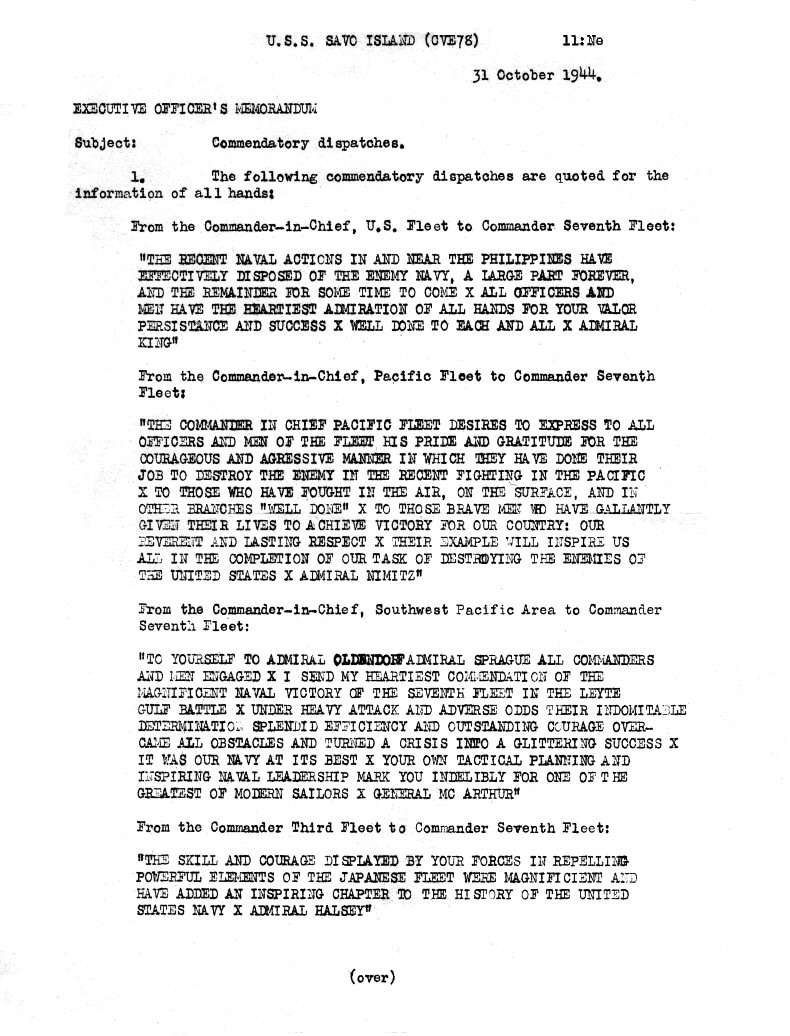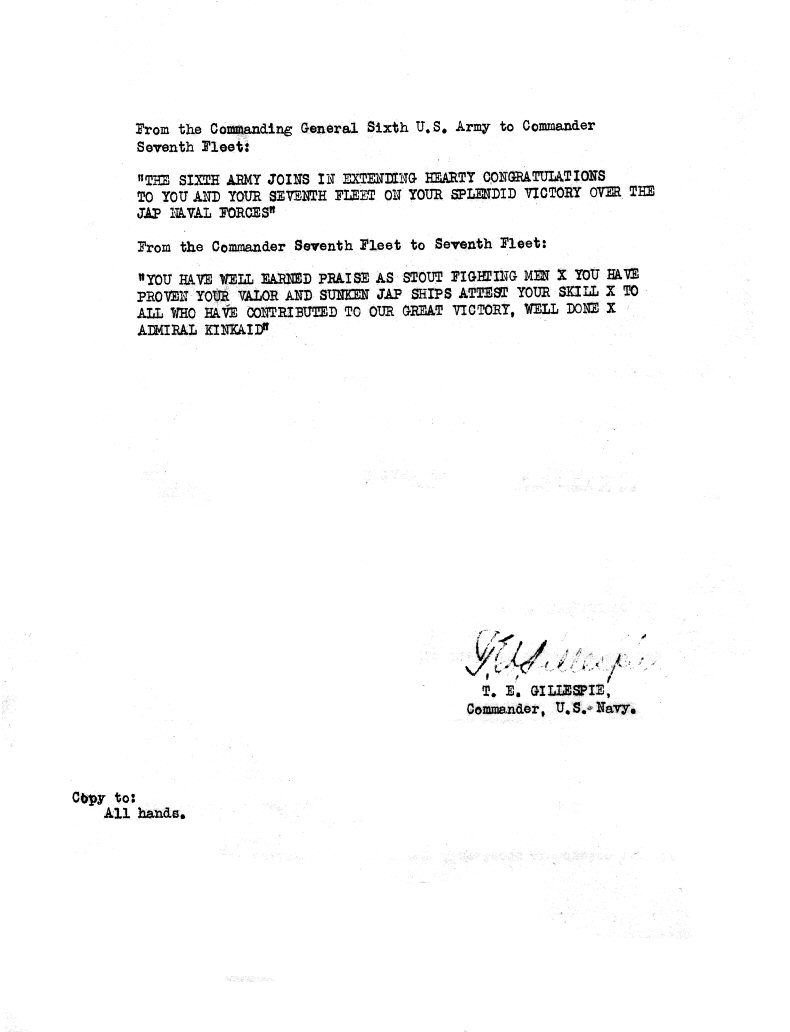
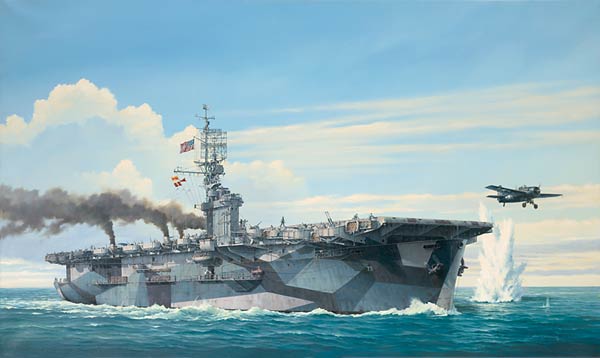 USS Gambier Bay (of Taffy 3) launches aircraft while under attack (by Marnii Chernev)
USS Gambier Bay (of Taffy 3) launches aircraft while under attack (by Marnii Chernev)
In October, the Japanese sent a large fleet to attack the American fleet supporting the troops who were trying to retake the Philippines.
Part of the plan involved creating a diversion to lure Admiral Halsey away from the beachhead at Leyte Island.
Halsey took the bait, leaving behind only a light force of jeep carriers, destroyers and destroyer escorts to protect the beachhead.
These were the ships of "Taffy 1", "Taffy 2" and "Taffy 3".
The U.S.S. Savo Island was part of Taffy 2 (TU 77.4.2) under the command of Rear Admiral B. Felix Stump.
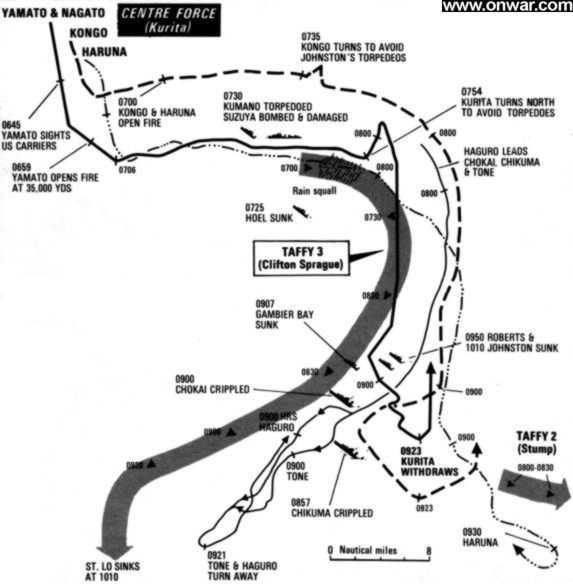 The Japanese attacked Taffy 3 from the northwest.
At the start of the battle, Taffy 2 was about 30 nm southeast of Taffy 3.
By the end of the battle, Taffy 3 and some ships of the Japanese fleet had passed within a few miles of Taffy 2.
Taffy 1 was about 50 nm further south and was closest to the invasion fleet.
The Japanese attacked Taffy 3 from the northwest.
At the start of the battle, Taffy 2 was about 30 nm southeast of Taffy 3.
By the end of the battle, Taffy 3 and some ships of the Japanese fleet had passed within a few miles of Taffy 2.
Taffy 1 was about 50 nm further south and was closest to the invasion fleet.
On the morning of October 25, Taffy 3 was surprised by the appearance of a Japanese battle group consisting of 4 battleships (including the mighty Yamato), 6 heavy cruisers, 2 light cruisers and 11 destroyers. Taffy 3 included only 6 jeep carriers, 3 destroyers and 4 destroyer escorts. The jeep carriers were defenseless against this battle group and were forced to run. But the Japanese fleet was faster and started lobbing shells into the carriers. The only thing that stood between the carriers and the Japanese fleet were the destroyers and destroyer escorts of Taffy 3 and about 500 planes from the Taffy group. The destroyers and destroyer escorts made heroic charges against the Japanese fleet, launching torpedoes. In the meantime, the 500 planes of the Taffy group, including the U.S.S. Savo Island, attacked the Japanese fleet and attempted to divert their attention from the ships of Taffy 3. Together, the ships and planes sank or damaged several ships, causing the Japanese fleet to regroup and, eventually, retreat. This was one of the greatest battles in naval history.
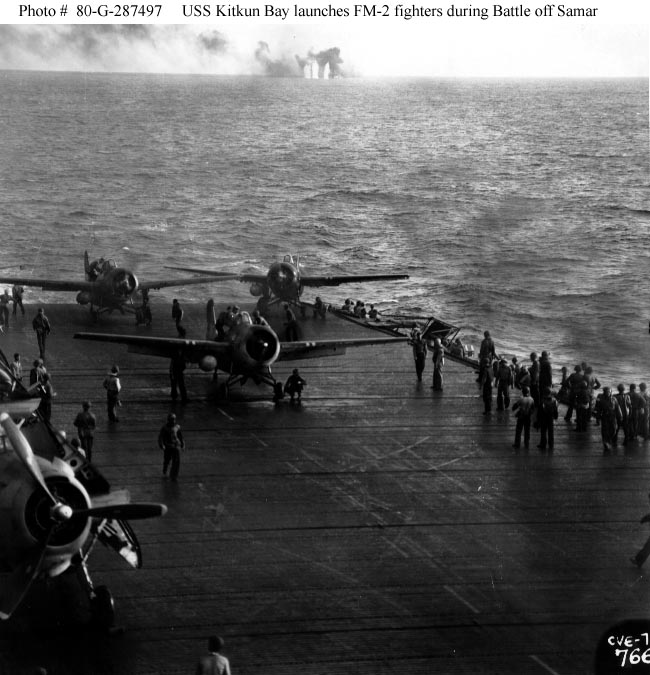 The men from the U.S.S. Savo Island would have seen a similar view as they were launching planes.
The men from the U.S.S. Savo Island would have seen a similar view as they were launching planes.
VC-27 and the U.S.S. Savo Island played a major role in that action. VC-27 launched 6 strikes that day. The statistics indicate that VC-27 sank 3 ships (including the HIJMS Chikuma) and damaged 12 ships and 1 submarine and scored 67 hits on Japanese Men O' War. 4 pilots from VC-27 received Navy Crosses for extraordinary heroism.
VC-27 also lost 6 aircraft: 5 Wildcats flown by Ens Frank M. Leighty, Ens Wilton O. Stubbs, Ens Sterling P. Ross [KIA], Lt Roger J. Mulcahy, Jr., and Ens Robert C. Ashcraft; and an Avenger flown by Ens Harold B. Harms. Following the battle, VC-27 lost 3 more Wildcats, flown by Ens Frederick W. Barnett, Ens Charles W. Snyder [KIA], and an unknown pilot.
The ships of Taffy 1 suffered the most in this engagement, including the escort carrier U.S.S. Gambier Bay (CVE 73), which was sunk by the HIJMS Chikuma. The next day, the kamikaze attacks began in earnest and another escort carrier, the U.S.S. St. Lo (CVE 63), was sunk.
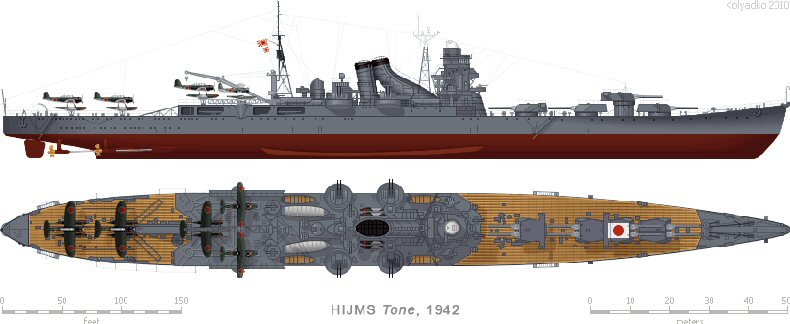
The Heavy Cruiser Chikuma - a Tone-Class Cruiser |
|
|---|---|
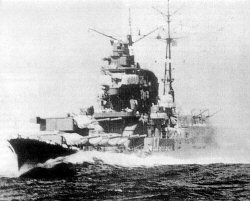
The HIJMS Chikuma was a heavy cruiser.
In addition to attacking the U.S.S. Heermann (DD-532), as described below, the Chikuma also sank the U.S.S. Gambier Bay (CVE-73).
|
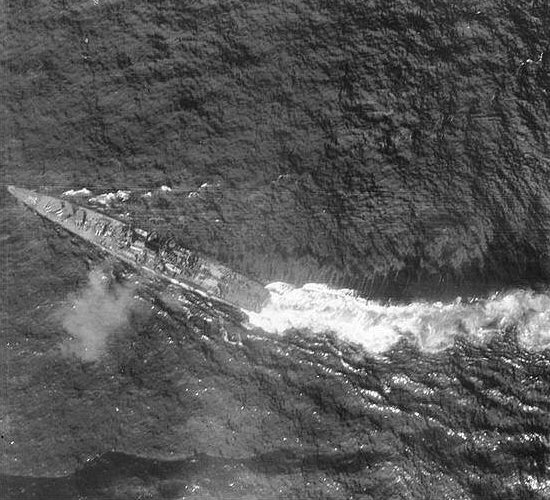
The Chikuma under portside attack by VC-27 |
The following narrative shows the crucial role that VC-27 played by sinking the Chikuma and saving the Heermann (DD-532):
The only chance for survival of the little group of light American ships lay in slowing the advances of the enemy warships while withdrawing toward Leyte Gulf and hoped-for assistance. The carriers promptly launched their planes to attack the Japanese vessels, and the escorts promptly set to work generating smoke to hide the American ships.
Heermann, in a position of comparative safety on the disengaged side of the carriers at the start of the fight, steamed into the action at flank speed through the formation of "baby flattops" who, after launching their last planes, formed a rough circle as they turned toward Leyte Gulf. Since smoke and intermittent rain squalls had reduced visibility to less than 100 yards, it took alert and skillful seamanship to avoid colliding with friendly ships during the dash to battle. She backed emergency full to avoid destroyer escort Samuel B. Roberts and repeated the maneuver to miss destroyer Hoel as Heermann formed column on the screen flagship in preparation for a torpedo attack.
As she began the run, dye from enemy shells daubed the water nearby with circles of brilliant red, yellow, and green. Heermann replied to this challenge by pumping her 5-inch shells at one heavy cruiser, Chikuma, as she directed seven torpedoes at another, Haguro. When the second of these "fish" had left the tube, Heermann changed course to engage a column of four battleships whose shells began churning the water nearby. She trained her guns on Kongo, the column's leader, at whom she launched three torpedoes. Then she quickly closed Haruna, the target of her last three torpedoes, which were launched from only 4,400 yards. Believing that one of the "fish" had hit the battleship, she nimbly dodged the salvoes which splashed in her wake as she retired. Japanese records claim that the battleship successfully evaded all of Heermann's torpedoes, but they were slowed down in their pursuit of the American carriers. The giant, Yamato, with her monstrous 18.1-inch guns, was even forced out of the action altogether when, caught between two spreads, she reversed course for almost 10 minutes to escape being hit.
Heermann sped to the starboard quarter of the carrier formation to lay more concealing smoke and then charged back into the fight a few minutes later, placing herself boldly between the escort carriers and the column of four enemy heavy cruisers. Here she engaged Japanese cruiser Chikuma in a duel which seriously damaged both ships. A series of 8-inch hits flooded the forward part of the plucky destroyer, pulling her bow down so far that her anchors were dragging in the water. One of her guns was knocked out but the others continued to pour a deadly stream of 5-inch shells at the cruiser, which also came under heavy air attack during the engagement. The combined effect of Heermann's guns and the bombs, torpedoes, and strafing from carrier-based planes was too much for Chikuma who tried to withdraw but sank during her flight.
As Chikuma turned away, heavy cruiser Tone turned her guns on Heermann who replied shell for shell until she reached a position suitable to resume laying smoke for the carriers. At this point planes from Admiral Stump's "Taffy 2" swooped in to sting Tone so severely that she too broke off action and fled. The courageous attacks of the destroyers and aircraft thus saved the outgunned task groups.
[Source: http://www.history.navy.mil/danfs/h4/heermann.htm]
